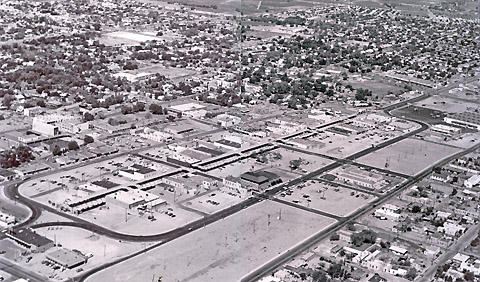Downtown Las Cruces, NM in 1974 after urban renewal. Courtesy of Placemakers
Over the years, a number of us in the urban design field have taken to the term "urban removal" instead of "urban renewal," since that's effectively what happened in city after city from the 1950's all the way up to current times. So-called urban renewal plans often actually meant removing a neighborhood and its associated life in favor of big roads, parking, or contemporary architecture. Very rarely did it actually lead to any renewal.
We often think of large cities and their downtowns when we talk of these types of changes, but they happened everywhere. Andrew von Maur writes about Las Cruces, NM, and the damaging impact an urban removal scheme had on its downtown. The post is beautifully illustrated, and is a great compare and contrast showing just how off-track the planning profession got in the 20th century. It perfectly describes not only how these ideas were destructive of cities, but bad for human beings. A couple of key quotes:
The stunning aerial view from 1974 shows the city after its failed open-heart surgery. Even today, after a heroic struggle to dismantle the virtually abandoned pedestrian mall and reinstitute automobile-access on Main Street, the pain of this flattening experience lingers on. The place is deserted on a beautiful September evening.
...
The demolition of the city center is understood as an epic mistake by almost everyone here, but have we learned the important lessons from the tragedies of Urban Renewal? Some time ago I was having dinner with a local planner who lamented the loss of downtown Las Cruces through Urban Renewal but then immediately suggested that the demolished properties were in serious disrepair and that despite the relatively active merchant scene in the 1960s “probably needed to be torn down.” It was like I was re-witnessing the introductory scene in The Death and Life of Great American Cities, in which Jane Jacobs’ city planner acquaintance acknowledges that life in Boston’s North End is generally functional and healthy while in the same breath condemning it as a slum that deserves to be razed. Fifty years later, planners still seem to miss how the physical environment helps to support social, cultural, and economic resilience.
If you got value from this post, please consider the following:
- Sign up for my email list
- Like The Messy City Facebook Page
- Follow me on Twitter
- Invite or refer me to come speak
- Check out my urban design services page
- Tell a friend or colleague about this site

